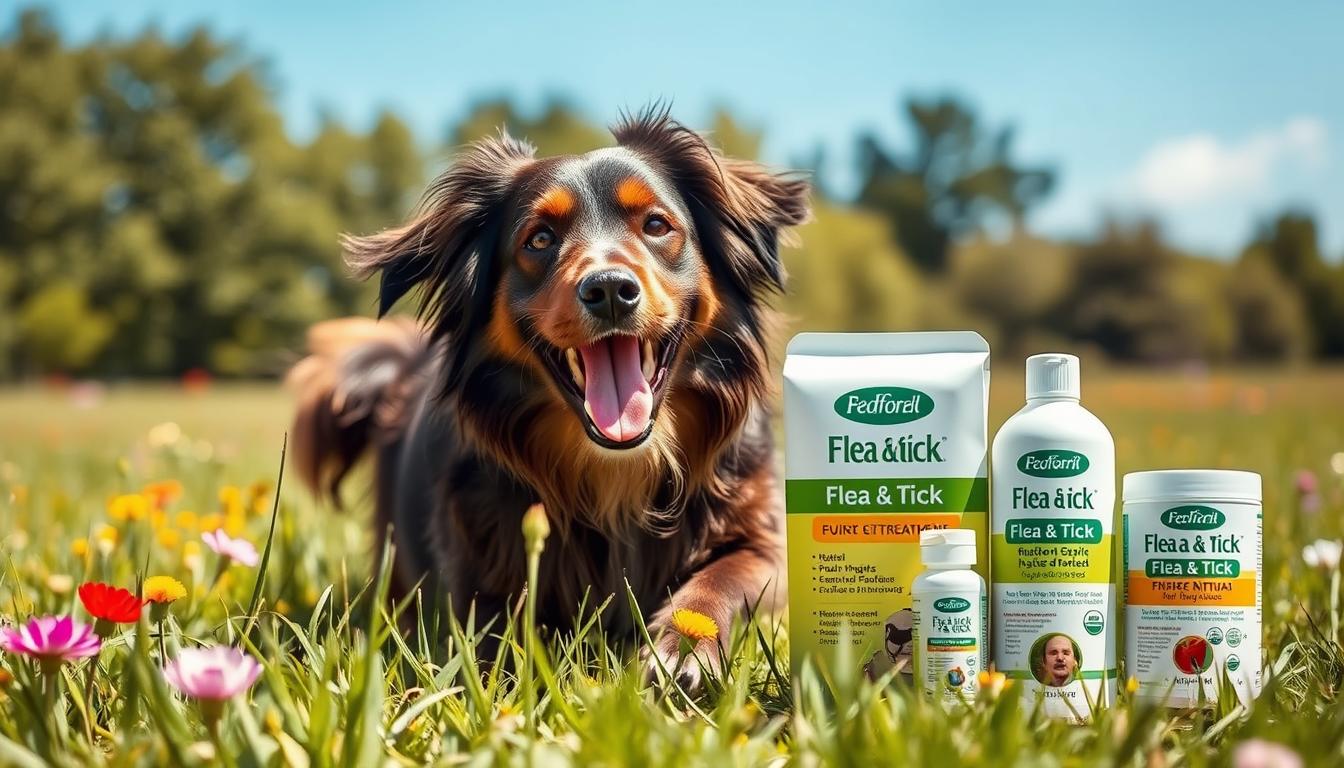As a devoted dog owner, I know how crucial it is to keep my furry friend healthy. Fleas and ticks are a big concern because they can harm my dog’s health. I’m excited to share effective solutions to keep your pup safe and comfortable.
In this guide, we’ll cover why flea and tick control is important. We’ll look at both natural and chemical treatments. Plus, we’ll give you tips to prevent these pests. By the end, you’ll know how to choose the best treatment for your dog. This way, they can live a happy, healthy life without worrying about fleas and ticks.
Understanding the Importance of Flea and Tick Control
Keeping your dog healthy and happy is a big deal for any pet owner. But fleas and ticks can be a big problem. They cause discomfort and can spread diseases. It’s important to know how they affect your dog’s health and the environment.
The Health Risks Posed by Fleas and Ticks
Fleas and ticks are more than a nuisance. They can make your dog very sick. Fleas can cause skin problems and allergies. Ticks can spread diseases like Lyme disease.
These parasites can also lead to serious infections. Keeping your dog safe from fleas and ticks is key to their health.
The Environmental Impact of Infestations
Fleas and ticks can harm more than just your dog. They can spread in outdoor areas, affecting public spaces. Unchecked, they can upset the balance of nature, harming other animals and ecosystems.
Controlling fleas and ticks is important. It keeps your dog safe and helps the environment. Using the right treatments and prevention is crucial for your dog’s health and the environment’s.
Dog Flea and Tick Treatment: A Comprehensive Approach
Managing dog fleas and ticks needs a full plan that uses many treatment methods. Knowing how to control fleas and ticks helps keep dogs safe from these pests. This is important for their health and happiness.
A good plan for treating fleas and ticks includes several steps:
- Topical Treatments: Spot-on or spray-on products kill and keep away fleas and ticks.
- Oral Medications: Chewable tablets or flavored supplements kill fleas and ticks inside the dog.
- Environmental Control: Cleaning living spaces, bedding, and outdoor areas gets rid of fleas and ticks.
Using these methods together helps stop fleas and ticks from coming back. This way, dogs get full protection against these pests. It makes sure all parts of the flea and tick life cycle are targeted.
It’s key for pet owners to know how to control fleas and ticks. A complete plan helps manage these pests. This keeps dogs safe and healthy, giving them the care they need.
Natural and Safe Flea and Tick Remedies

As a dog owner, I know how crucial it is to protect my pet from fleas and ticks. Many prefer natural methods over chemical treatments. We’ll look at natural flea and tick remedies, including essential oils.
Essential Oils and Their Effectiveness
Essential oils are becoming a popular choice for flea and tick control. They are plant-based and gentle on your dog’s skin and the environment. Some top essential oils for this purpose are:
- Peppermint oil: Known for its strong, minty aroma, peppermint oil can help deter fleas and ticks.
- Lemongrass oil: This citrusy oil has natural insecticidal properties that can be effective against these pests.
- Cedarwood oil: The woody scent of cedarwood oil can help create an unfavorable environment for fleas and ticks.
- Lavender oil: The calming aroma of lavender oil not only repels pests but can also soothe your dog’s skin.
When using essential oils, it’s important to dilute them properly and apply them in a safe manner, following the instructions on the product label. These natural remedies can be a great addition to your dog’s flea and tick control routine.
Remember, while natural remedies can be effective, it’s always a good idea to consult with your veterinarian to ensure the safety and well-being of your furry friend.
Chemical-Based Flea and Tick Treatments

Sometimes, we need to use chemical treatments to fight off fleas and ticks. This is especially true for severe cases or in certain situations. Let’s look at the different chemical options, including prescription and over-the-counter products. We’ll discuss their good and bad points to help you choose the best for your dog.
Prescription Flea and Tick Medications
Prescription treatments are often stronger and more effective. Vets create these products, and they last longer. Some well-known ones are:
- Nexgard – An oral chewable that kills fleas and ticks for up to 30 days
- Bravecto – A single-dose oral treatment that provides 12 weeks of protection
- Frontline Plus – A topical treatment that kills fleas, ticks, and other parasites
Over-the-Counter Flea and Tick Products
For those looking to save money, over-the-counter options are available. These include sprays, shampoos, collars, and spot-on treatments. They might not be as strong as prescription meds but can still help control infestations. Some popular ones are:
- Seresto Flea and Tick Collar – Provides up to 8 months of protection
- Adams Plus Flea and Tick Spray – Kills fleas, ticks, and flea eggs
- Frontline Gold Spot-On – A topical treatment that kills fleas and ticks for up to 30 days
When choosing chemical treatments, think about the pros and cons. Always talk to your vet and follow the product instructions carefully. Knowing your options helps you protect your dog safely and comfortably.
| Product | Type | Duration of Protection | Key Benefits |
|---|---|---|---|
| Nexgard | Prescription Oral Chewable | Up to 30 days | Effective against fleas and ticks |
| Bravecto | Prescription Oral | 12 weeks | Provides long-lasting protection |
| Frontline Plus | Prescription Topical | Up to 30 days | Kills fleas, ticks, and other parasites |
| Seresto Flea and Tick Collar | Over-the-Counter Collar | Up to 8 months | Provides extended protection |
| Adams Plus Flea and Tick Spray | Over-the-Counter Spray | Varies | Kills fleas, ticks, and flea eggs |
| Frontline Gold Spot-On | Over-the-Counter Topical | Up to 30 days | Effective against fleas and ticks |
Preventative Measures for Flea and Tick Control

Keeping your dog safe from fleas and ticks is key to their health. By taking proactive steps, you can lower the risk of these pests and the diseases they bring. Here are some important steps to take:
Grooming and Cleaning Tips
Regular grooming and cleaning are vital to keep your home and yard free of fleas and ticks. Brush your dog every day to catch any pests. Then, bathe them with a safe shampoo to get rid of fleas and ticks.
Vacuum all areas where your dog hangs out to get rid of eggs and larvae. Also, wash your dog’s bedding, blankets, and toys in hot, soapy water. This will kill any fleas or ticks hiding there. Use pet-friendly insecticides or natural repellents around your home and yard to keep pests away.
- Brush your dog daily to remove pests
- Bathe your dog with a pet-safe shampoo
- Vacuum carpets, upholstery, and other areas
- Wash your dog’s bedding, blankets, and toys
- Treat your home’s perimeter and yard with repellents
By following these grooming and cleaning tips, you can keep your dog’s environment free from fleas and ticks.
Choosing the Right Flea and Tick Treatment for Your Dog
Choosing the right flea and tick treatment for your dog can be tough. There are so many options out there. But, by looking at a few key factors, I can make a good choice. This choice will keep my dog safe and healthy.
First, I’ll think about my dog’s age, size, and health. Some treatments aren’t good for puppies or older dogs. I’ll also check if my dog’s weight fits the treatment’s dosage.
Next, I’ll think about what I prefer. Do I want something natural or a chemical treatment? This helps me find a treatment that fits my values and my dog’s needs.

